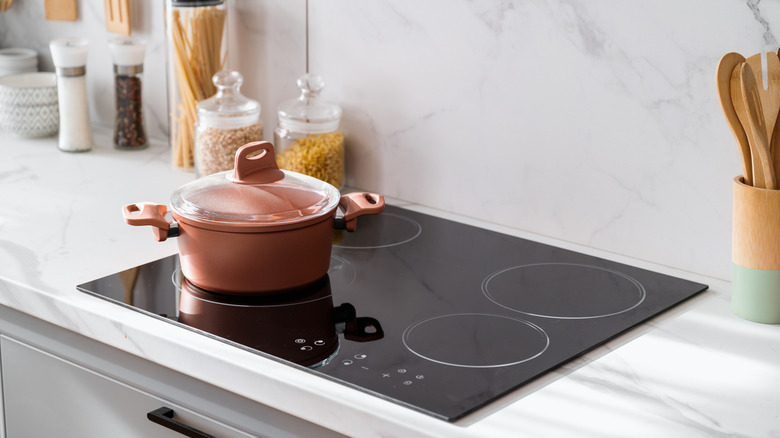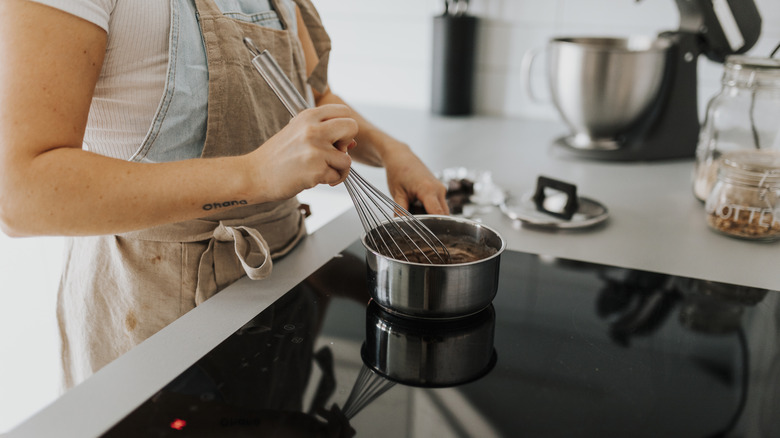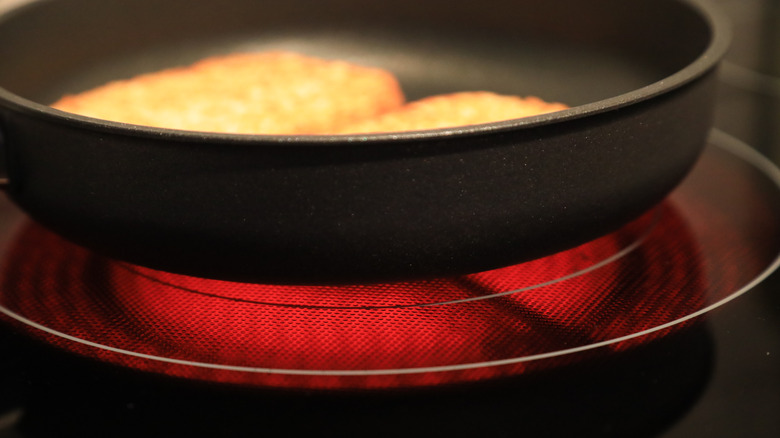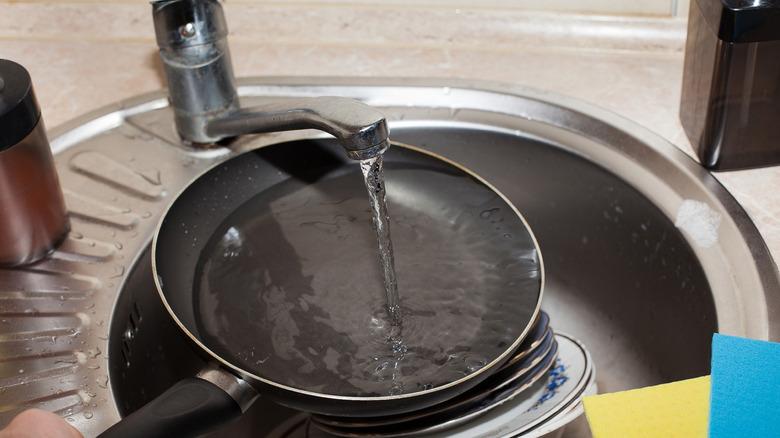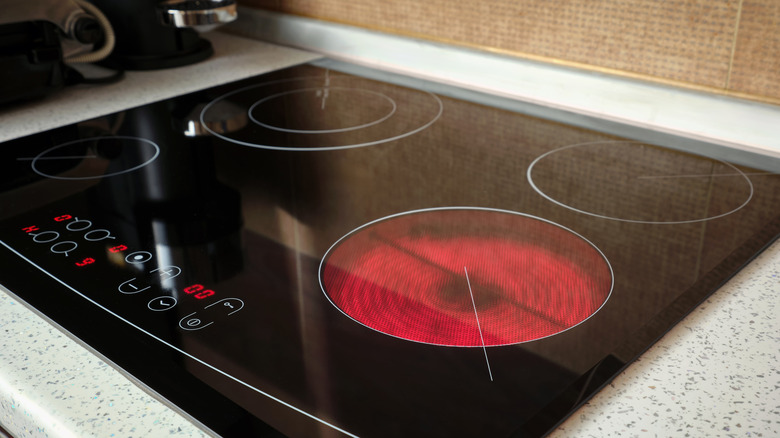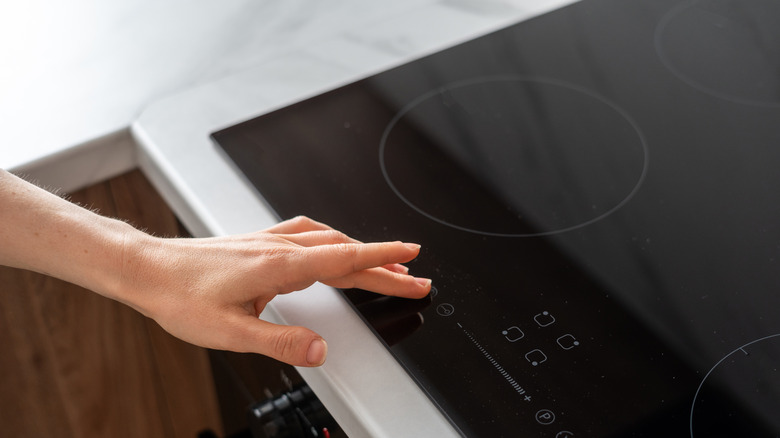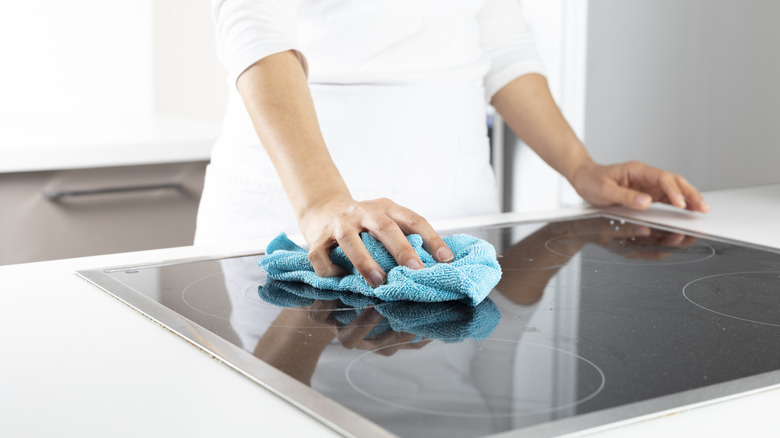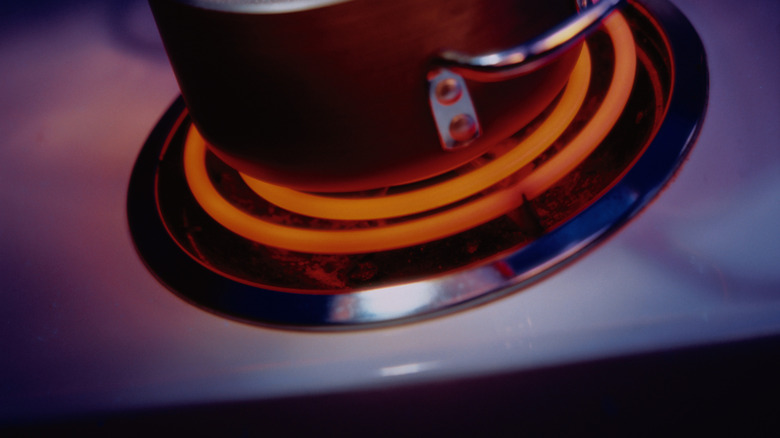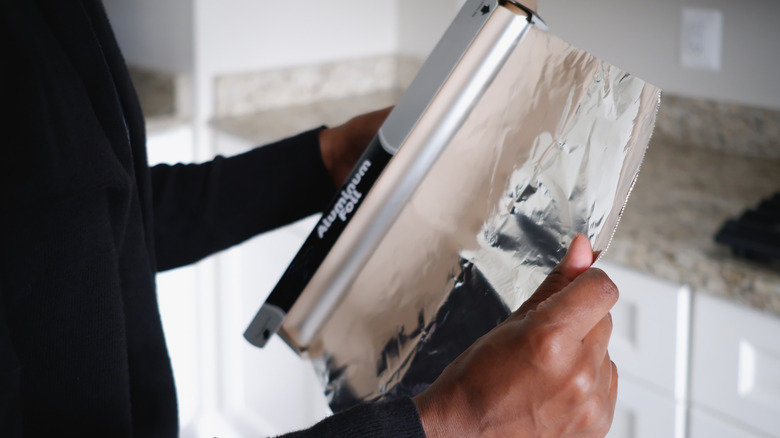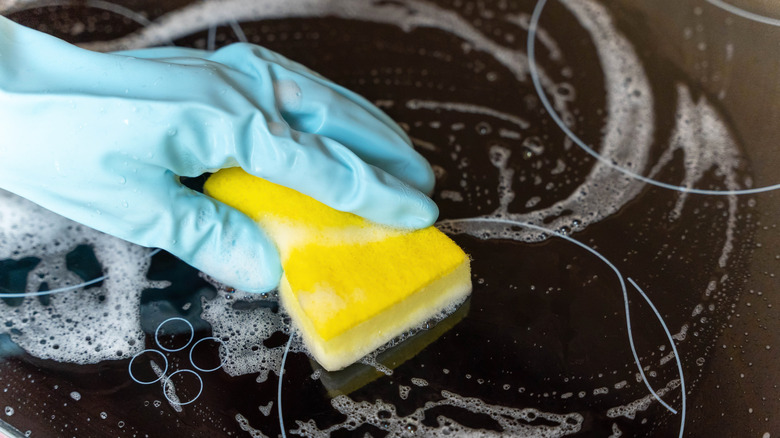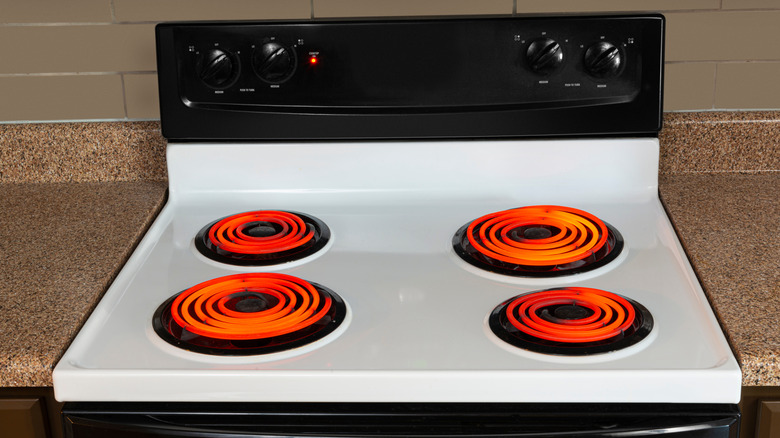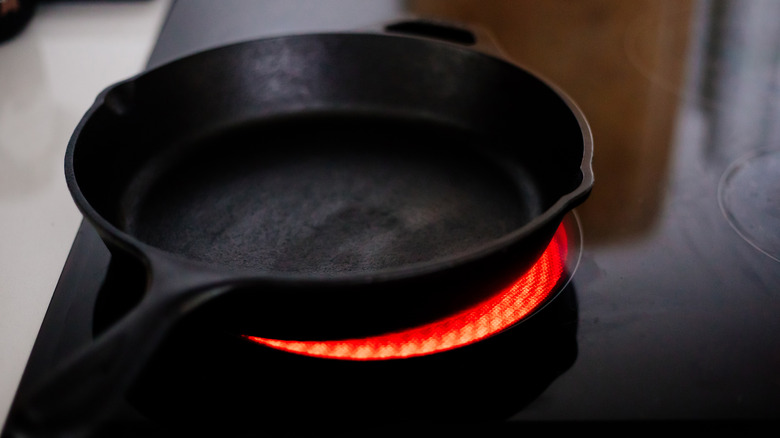11 Things You're Probably Doing Wrong On Your Electric Stove
It might seem like a simple appliance, but there are some things you're probably doing wrong on your electric stove. Say you're trying to make a simple weeknight dinner. The recipe is foolproof and you've got all the ingredients, but something just isn't right. The pan isn't getting hot enough, or it's getting hot too quickly, and you're left with a scorched mess or a sad, pale piece of protein. More often than not, the issue isn't with your cooking skills, but with the stove.
Many home cooks learn the hard way that electric stoves are a totally different beast from their gas-powered counterparts. They have their own set of quirks, and if you don't know the rules, you're fighting an uphill battle. Perhaps you've just realized that you've been using your stove all wrong, or you might have been suspecting this for months. Either way, learning how to work with an electric stove can unlock a whole new level of cooking.
This guide is for everyone who's ever felt defeated by their stove. We're going to get into the common mistakes people make with electric burners and, more importantly, how to fix them. From choosing the right pans to mastering that elusive heat control, here 11 things you're probably doing wrong on your electric stove, and how you can start doing them right.
Mistaking traditional electric and induction cooktops
So, you've got an electric stove, but what kind of stove is it? This is a question many people don't ever consider. The two most common types of electric stovetops are traditional electric (with visible heating coils or plates, or a smooth ceramic top) and induction cookers. While they both run on electricity, they're worlds apart in how they work and what they can do.
Traditional electric stoves heat up a coil or another heating element, which then heats the pan. It can take a while for the stovetop to heat up, and the heat continues to radiate even after you turn the burner off. This means that you might find it less responsive if you're someone who's used to cooking on a gas stove. It's harder to make those small adjustments needed to really finesse a dish because your stove takes a while to catch up.
Induction models are a different story. They use an electromagnetic field to directly heat the cookware itself, not the stovetop. This means the surface stays cool to the touch while the pan heats up. This direct heat transfer is incredibly efficient and gives you precise, immediate temperature control, similar to cooking with gas. Traditional electric models tend to be more common because they're affordable, but induction stoves are what keen cooks generally prefer.
Using incompatible or incorrectly sized pans
One of the most common kitchen missteps is using incompatible or incorrectly sized pans. When you use pans too big or too small for the burner, you can waste energy and run into other issues. Meanwhile, using incompatible pans on electric induction stoves just won't work at all.
Using cookware that's too small for the burner is a major waste of energy, as the cooktop will be trying to heat an area much larger than the pan itself. On the flip side, using a pan that's too large for the burner will lead to uneven cooking. The center of the pan will get hot and cook your food quickly, while the outer edges will be cooler. This is a common culprit behind a dish that's scorched in the middle but raw on the sides. Plus, what many people don't realize is that smaller burners often have a lower energy output and heat food more gently. This is great when you want fine control, but if you want to boil a pan of water quickly, larger burners are where it's at.
When cooking on an induction stove, the type of pan you use is something to consider. The magnetic field that creates the heat on an induction cooktop needs a compatible ferromagnetic pan to work. It's the reason a glass bowl or an aluminum pot won't heat up on an induction surface. The quickest way to check if your cookware will work is to simply hold a magnet to the bottom of the pan. If it sticks, you're good to go. Cast iron and many types of stainless steel pans work, too.
Using warped or uneven cookware
Using a pan with a warped or uneven bottom is a surefire way to get bad results on any electric stovetop. When the underside of a pan isn't making full contact with the burner, there's a serious loss of heat transfer. This means you're left with frustrating hot spots and cold spots, leading to uneven cooking. It will cause your oil to pool at the edges, leaving your food to fry in some spots and steam in others. On an induction cooktop, this issue is even more critical because the electromagnetic field requires a flat, even surface to transfer heat efficiently.
Warping often happens over time. It can come from the common but damaging kitchen habit of running a hot pan under cold water right after you're done cooking. The rapid temperature change is a shock to the metal, causing it to expand and contract unevenly, ultimately distorting its shape. To avoid this, always let your pans cool down on their own to preserve their flat bottom.
That said, you might find some pans with a slight concave in them. This is a raised center like a little mound. Some materials flex a little when heated, and this concave design means pans flatten out fully when they're on the burner.
Not preheating properly or leaving burners on high unnecessarily
You know you should always preheat your oven, but what about your stove? A common mistake with traditional electric stoves is failing to preheat properly. Unlike gas burners and electric induction stoves, which provide instant heat, electric coil and glass-top models have a significant lag time. They need time to heat up to your desired temperature before you add any ingredients. Dropping food onto a cold or lukewarm burner will result in soggy textures and uneven browning.
Most recipes call for preheating a pan for a few minutes before you add oil or food, and this step is even more critical for electric stoves. This initial wait is the key to creating a hot, stable surface for searing, sautéing, or frying. Before you even heat the pan, an electric burner may need 10 to 15 minutes to heat up fully. It's worth popping it on while you chop your onions or take care of other prep.
On the flip side, leaving a burner on high unnecessarily is just as big a problem. Since electric burners retain heat for a long time, keeping the heat cranked up can easily scorch your food or make dishes simmer over, especially if you step away for a moment. Instead, learn to adjust the temperature as you cook. It can be a tricky balance to get right if you're not used to it, but it will become second nature.
Misinterpreting temperature settings
One of the biggest frustrations with traditional electric stoves is the lack of precision. You've got "low" through "high," but those aren't exactly standardized. The number 5 on one stove might be completely different from the number 5 on another. This can lead to a lot of guesswork and ruined dishes. Setting the temperature too high will burn the outside of your food before the inside is cooked, while setting it too low will lead to a long, drawn-out cooking process and a lackluster texture.
So, it's important to know what you can achieve from each temperature setting on your stove. Low is generally a simmer setting, letting you slowly warm delicate sauces and anything else that doesn't want too much heat. A medium heat is good for most cooking tasks, like sautéing or searing, while a high heat is good for boiling water or bringing things to the boil, but can stay hot long after turning it down, so proceed with caution.
To get more control, use two burners. Set one burner to a higher heat for searing and browning, and another to a lower, gentler setting for simmering or keeping food warm. This allows you to quickly move your pan between the two different heat zones without waiting for the burner to cool down or heat up. It's a great way to mimic the quick temperature changes that gas stoves are known for, and gives you much more control over your cooking.
Neglecting surface maintenance
Keeping your stovetop clean is a simple but essential step that many people overlook. On a smooth-top electric stove, a grimy surface can actually affect how your cookware heats up. Spills and burned food create a layer that prevents the pan from making full, direct contact with the heating element. This leads to uneven cooking and a serious waste of energy, as the stove has to work harder to transfer heat. This goes for both glass, coil, and induction models.
Beyond a simple wipe-down, it's also smart to periodically check your heating elements. On coil stoves, look for any damage or coils that don't glow a uniform red when on high heat. If a coil is unevenly colored or seems to be struggling, it might not be heating correctly. For glass-top stoves, you can look for cracks or bubbling under the surface. If you see any signs of damage, or if you suspect your stove isn't working as it should, don't hesitate to call a professional. A qualified technician can check for electrical issues, diagnose problems with heating elements, and ensure your stove is working safely and efficiently. A little maintenance can save you a lot of headache in the long run, but it's something that a lot of people neglect.
Using a burner that only works on high
It's common to find an old electric stove where one burner seems to have just two settings: off, and burn-your-dinner-to-a-crisp high. Maybe the low and medium settings stopped working years ago, or maybe the thermostat on that specific burner is broken. Many people simply resign themselves to avoiding that burner or only using it for boiling water, which is a major mistake that limits your cooking space.
Ignoring a faulty burner means you're missing out on a usable cooking surface, More importantly, it means you're operating with an unpredictable appliance. A burner stuck on high is not only inefficient, but it's a constant safety hazard, as it can overheat oils and food almost instantly. While it might seem like a minor inconvenience, this issue often signals a deeper problem with the range's infinite control switch. This switch controls the cycling of the electricity to regulate the heat. If it's malfunctioning, the burner will just stay on full power.
The good news is that this switch is often inexpensive and simple to replace. If you're a confident DIY-er, you may be able to replace it yourself. Otherwise, it shouldn't cost much to get a professional in to do the job. Don't limit your cooking by ignoring a faulty burner — get it fixed so you can use your whole stovetop reliably.
Covering an electric cooktop with aluminum foil
This mistake is common and surprisingly dangerous. Many people like the look of a clean stovetop and use aluminum foil to line the drip pans beneath the electric coils on old-school electric stoves. The thinking is that spills and drips will land on the foil, which can then be easily removed and tossed. While it seems like a great, low-effort cleaning hack, it's actually a major safety hazard that can damage your stove.
Aluminum foil is highly reflective, and when placed near the heating element, it can reflect heat back towards the burner's control elements. This can cause the burner to overheat and potentially short-circuit or even cause a fire. More commonly, the foil can shift, blocking the airflow and preventing the stove from distributing heat correctly, leading to those frustrating uneven cooking results. Some drip pans are designed to be removable and should be cleaned regularly with soap and water — no lining required. Otherwise, you can clean them with a sponge when your cooker is cool. Skip the foil and stick to scrubbing to keep your kitchen safe and your stove working correctly.
Using abrasive cleaners on cooktops
If you make the switch from gas to an electric stove, you should learn how to clean it properly. But even if you've always had an electric stove, you could still be doing it wrong. One of the quickest ways to ruin the sleek look and functionality of a smooth glass-ceramic or induction stovetop is by reaching for the wrong cleaner. Using rough cleaning pads (like steel wool or tough scouring pads) or harsh chemicals with abrasives is a major mistake.
These cooktops are designed to be easy to wipe down, but they're not indestructible. Scrubbing with something rough creates tiny, hairline scratches on the surface. These little scratches don't just look bad, they can actually compromise the stovetop's performance over time. A severely scratched surface may transfer heat less effectively, leading to slow or uneven cooking. Scratches can also make the surface more susceptible to future damage, like chipping or cracking.
The best way to clean these surfaces is to use a soft cloth or sponge and a cleaner specifically made for glass-ceramic or induction cooktops. For tough, burned-on spills, let a specialized cooktop cleaner sit for a few minutes to soften the mess. Treating your cooktop with care and cleaning it gently will help keep it in good condition.
Not letting burners cool fully before cleaning
It's a common impulse after cooking a great meal: You see a splatter and want to wipe it up immediately. But with electric stovetops, particularly glass and ceramic models, cleaning before the burners have fully cooled is a significant mistake.
First, think about your wellbeing when cleaning your stovetop. It's easy enough to rub your skin on a hot stove, causing burns. Plus, if you spray a cleaning product directly onto a hot stove, it can vaporize, and you could end up breathing it in. You can also melt synthetic rags and sponges onto the stove, which can create fumes as well as getting stuck to the stove, leaving you with a bigger mess to clean up than a splatter of sauce or oil. What's more, cleaning a still-hot stove can be less effective, as the cleaning products evaporate before working their magic.
The rule here is patience. Always allow the surface to cool completely before you begin cleaning. A cool stovetop is safer and easier for you to clean, so enjoy your meal, chill out, and leave the tidying up for later.
Dragging heavy cookware across a glass cooktop
One of the sleekest features of modern electric stoves is the flat, seamless look of a glass cooktop, but that smooth surface is more vulnerable than it looks. Dragging heavy pots and pans across the glass can damage it. It's an easy habit to fall into, especially when moving a large pot full of water or a heavy cast-iron skillet.
When you slide a piece of heavy cookware, your cooktop can get scratches, scuff marks, and dull spots that permanently mar the smooth surface. This is caused by the rough surface on the underside of some pans, or by little particles of ingredients like salt or sugar getting caught underneath and acting like sandpaper.
The simple fix is to always lift and gently place your pots and pans onto the burner area. If you're using heavy cast iron, be extra careful: Its rough underside is notorious for scratching glass surfaces. Just a little extra care and attention will prevent any scratching.
